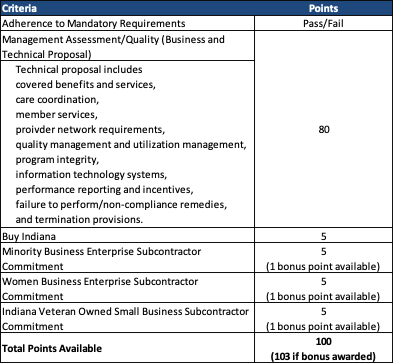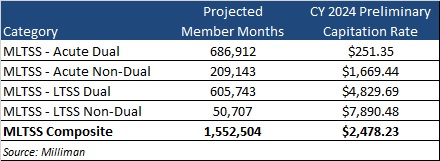This week, our In Focus section reviews the Indiana Medicaid managed long-term services and supports (MLTSS) request for proposals, released by the Indiana Department of Administration on behalf of the Family and Social Services Administration on June 30, 2022. Indiana is seeking three managed care organizations (MCOs) that will serve an estimated 106,000 enrollees, beginning January 1, 2024, for a period of four years, with two one-year renewal options.
MLTSS Program
Indiana began forming a plan to reform the state’s Medicaid LTSS services in 2019 by holding stakeholder meetings. The state estimated that from 2010 to 2030 the proportion of Hoosiers over age 65 will grow from 13 percent to 20 percent, and that the state’s system would need to be reformed to meet the growing demand. The state set an objective to shift the LTSS program to a managed care model and to move a higher percentage of new LTSS members into home and community-based settings.
The new statewide, risk-based MLTSS program will serve Medicaid beneficiaries who are aged 60 years and older and are classified as aged, blind, or disabled. These beneficiaries will include individuals who are dually eligible for Medicare and Medicaid, those in a nursing facility, and those who are receiving LTSS in a home or community-based setting.
Beneficiaries in this program will receive all traditional Medicaid services, delivered through a capitated managed care arrangement. Those who meet a specified level of care will be eligible to receive home and community-based services (HCBS) waiver services. The Medicaid Rehabilitation Option (MRO), Adult Mental Health Habilitation Services Program (AMHH), and Behavioral and Primary Care Coordination (BPHC) will be carved out of the capitated arrangement. For dually eligible beneficiaries, Medicare will be the first payer for all Medicare covered services, including services that are covered by both Medicare and Medicaid.
Indiana seeks to contract with MCOs that can address complex and chronic health conditions of the program population and integrate care along the continuum and settings of LTSS in the state. Program goals include simplifying access to HCBS and expanding the HCBS provider network, especially in rural areas; using a person-centered approach; improving quality outcomes and consistency of care across the delivery system; promoting caregiver support and skill development; in addition to others.
Timeline
The first part of the proposals is due September 19, with the second part due September 23. Awards are expected in February 2023.

Evaluation
After ensuring proposals meet the mandatory requirement, proposals will be scored out of a total possible 103 points, as shown in the table below.

Preliminary Capitation Rate Summary
Based on the preliminary calendar year 2024 capitation rate development, contracts are estimated to be worth $3.8 billion annually.
